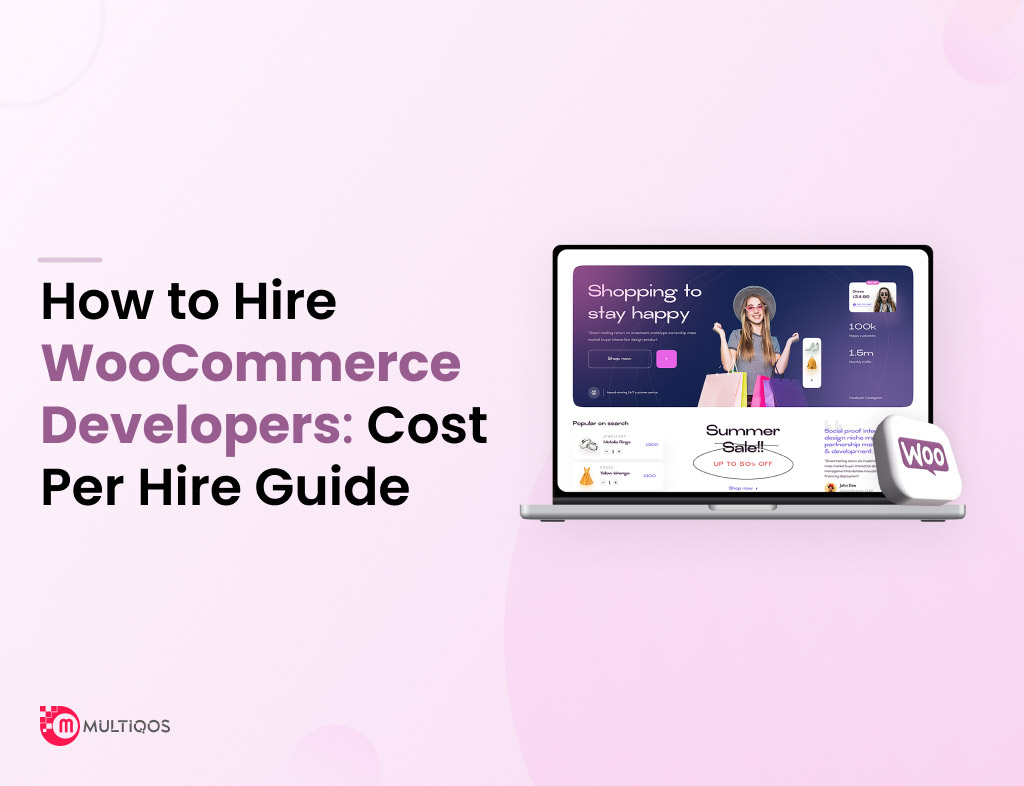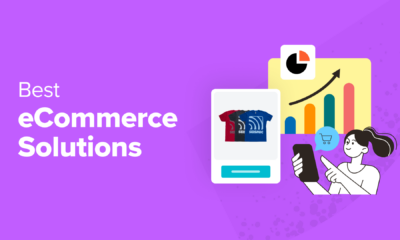WORDPRESS
How to Hire Best WooCommerce Developer with Minimal Budget?

In the realm of e-commerce, WooCommerce developers play a crucial role in creating successful online stores. This blog navigates the process to hire WooCommerce developers within a minimal budget, offering insights into the essential skill set, cost-effective hiring strategies, and key traits to look for.
In the wake of the pandemic, e-commerce firmly established itself as the cornerstone of the global retail landscape. Its astounding ascent, transformative capabilities, and ability to redefine the shopping experience solidified its position as an undeniable force. As we journey forward into the future, businesses that wholeheartedly embrace the ever-evolving dynamics of e-commerce are poised for resounding success in this digital retail age.
In an era where online shopping reigns supreme, the demand for e-commerce development has reached unprecedented heights. This surge in demand mirrors the shifting current of consumer behavior, with an unprecedented number of individuals opting for the convenience and accessibility of digital commerce.
As e-commerce continues to reshape the way we buy and sell, businesses must maintain agility and remain finely tuned to the evolving landscape. Those who not only adopt e-commerce but also adeptly navigate their ever-shifting currents are poised to thrive in this exciting new retail era.
-
- In 2021, an estimated 2.14 billion individuals globally engaged in online shopping, as per Statista data.
-
- Statista reports that mobile e-commerce comprised a significant 54.8% share of total e-commerce sales in 2021.
-
- Looking ahead, the global online grocery market is anticipated to soar, with projections indicating a value of $334 billion by 2025, according to Statista.
-
- A significant 49% of consumers show a greater tendency to shop online when tempted by the offer of free shipping, as revealed by Statista research.
As the world increasingly turns to online shopping, the demand for e-commerce has surged to unprecedented levels. With thousands of new e-commerce businesses emerging annually, the options for platforms to build online stores have never become more diverse. In this thriving ecosystem, one name stands out with undeniable prominence: WooCommerce. With a 25% market share in the e-commerce website space, WooCommerce powers over 3.5 million online stores, demonstrating its extensive adoption and influence in the industry.
The Significance of Hiring a Skilled WooCommerce Developer
The role of a skilled WooCommerce developer holds immense significance in crafting successful e-commerce platforms. These developers serve as the architectural masterminds, shaping the very foundation of online stores. Their profound expertise intricately shapes not only the visual appeal but also the underlying functionality, directly impacting the overall user experience. By meticulously crafting intuitive navigation, seamless checkout processes, and responsive designs, WooCommerce developers ensure that online shoppers engage effortlessly and convert seamlessly. Their ability to customize and optimize functionalities aligns the platform with specific business needs, ultimately contributing to the online store’s triumph in the competitive e-commerce landscape.
Budget Constraints and Finding the Right Fit
Striking a harmonious equilibrium between limited financial resources and the imperative for capable developers necessitates a tactical strategy. It’s crucial to identify developers who not only possess the necessary skill set but also align with the available budget. This balance ensures that quality isn’t compromised while adhering to financial limitations. A thorough evaluation of potential candidates’ portfolios, expertise, and reviews can facilitate finding the right fit that meets the project’s demands without straining resources.
Hire an In-house WooCommerce Developer or Outsource It: Making the Right Choice for Your Business
In our modern digital landscape, where e-commerce stands as a cornerstone of retail, businesses often find themselves at a crossroads: Should they hire an in-house WooCommerce developer or entrust this critical task to external experts? Each path has its own unique strengths and weaknesses, which have significant implications for the trajectory of a business. In this article, we thoroughly explore the merits and drawbacks of both options, providing you with the knowledge to make an informed decision that aligns perfectly with your business objectives.
In-House WooCommerce Developer: The Pros
-
- Dedication and Alignment: An in-house developer is fully committed to your project and deeply immersed in the organization’s culture, objectives, and aspirations. This deep immersion facilitated the seamless alignment of their work with the precise requirements of the business.
-
- Immediate Availability: Our in-house developers are readily available for meetings, discussions, and immediate issue resolution. Real-time access is crucial for addressing these urgent issues.
-
- Enhanced Oversight: You direct authority over the hiring process, training, and day-to-day supervision of an in-house developer. This level of control empowers you to tailor your responsibilities precisely to your specifications.
In-House WooCommerce Developer: The Cons
-
- High Investing Costs: Hiring and retaining in-house developers can be expensive. You will need a budget for their salary, benefits, office space, and equipment, which can strain your resources.
-
- Limited Expertise: Your in-house developer may have expertise in WooCommerce but might lack the diverse skills and experiences that an agency or outsourcing firm can offer.
-
- Resource Limitations: If project requirements fluctuate, an in-house developer might not always have the capacity to handle increased workloads effectively.
Outsourcing WooCommerce Development: The Pros
-
- Cost Efficiency: Outsourcing typically offers a cost-effective solution. You can choose a development team that fits within your budget and only pays for the specific services that you need.
-
- Access to Diverse Skills: Outsourcing agencies often have a team of experts with a wide range of skills and experience to ensure that the project benefits from the latest technologies and best practices.
-
- Scalability: Outsourcing offers flexibility. One can easily scale up or down based on project requirements without the burden of hiring or laying off employees.
Outsourcing WooCommerce Development: The Cons
-
- Less Immediate Control: Collaborating with an external team entails relinquishing a certain level of control over daily operations. Communication and coordination may require additional effort.
-
- Potential Communication Barriers: Collaboration may be affected by time-zone differences, language barriers, or cultural differences, depending on the location of the outsourcing partner.
-
- Security Concerns: When outsourcing, it is essential to carefully vet partners to ensure the security of data and intellectual property.
The decision to hire an in-house WooCommerce developer or outsource development depends on the business context. Let us consider the budget, project complexity, timeline, and long-term goals. A hybrid model combines in-house expertise for core tasks and the outsourcing of specialized projects when needed.
Essential Skillset to Consider When Hiring a WooCommerce Developer
When considering the hiring of a WooCommerce developer, within every WordPress development company a comprehensive skill set tailored to e-commerce development is paramount.
-
- Proficiency in PHP and WordPress: The mastery of PHP and WordPress Theme Development serves as a foundational requirement, forming the backbone for crafting WooCommerce plugins and themes.
-
- Experience with WooCommerce Plugin Development: A developer’s deep comprehension of WooCommerce’s plugin architecture ensures the seamless customization and integration of essential features.
-
- Knowledge of Front-end Technologies: The familiarity with HTML, CSS, and JavaScript is essential, guaranteeing the creation of visually appealing and responsive online stores.
-
- Familiarity with Payment Gateways and E-commerce Features: Developers well-acquainted with diverse payment gateways and e-commerce functionalities facilitate a streamlined shopping experience for users. Their ability to seamlessly integrate these features ensures a seamless transaction process.
How to Hire a Budget-Friendly WooCommerce Developer?
When aiming to hire an affordable WooCommerce developer without compromising quality, employing strategic approaches becomes pivotal.
-
- Exploring Freelancers and Development Companies: Freelancers can offer cost-effective solutions, while development companies provide a collaborative team dynamic for more complex projects.
-
- Assessing Cost-Effectiveness and Quality: Opt for value rather than solely focusing on the lowest cost. Evaluate a developer’s experience and portfolio to ensure optimal results.
-
- Negotiating Rates and Project Scope: Engage in transparent communication about budget constraints and project scope. Open discussions can lead to mutually beneficial agreements that accommodate both parties. By considering these strategies, businesses can strike the right balance between budget constraints and obtaining the desired quality in WooCommerce development projects.
Key Traits of a Skilled WooCommerce Developer
A skilled WooCommerce developer or WooCommerce development company in India Exhibits distinct traits that contribute to their effectiveness.
-
- Proficient Customization and Theme Development: A developer’s ability to create bespoke solutions and themes elevates the brand’s uniqueness and recognition.
-
- Seamless Integration of E-commerce Functionality: Expertise in integrating payment gateways, shipping choices, and inventory management ensures a seamless and satisfying customer shopping journey.
-
- Timely Delivery and Post-Development Support: A dependable developer adheres to deadlines, ensuring on-time project completion, and offers post-launch support to resolve any issues that may arise. These qualities collectively define a skilled WooCommerce developer’s capability and contribute to the success of e-commerce endeavors.
Selecting the Right WooCommerce Developer: Best Practices
When it comes to selecting the appropriate WooCommerce developer, employing effective strategies is key.
-
- Conducting Technical Interviews and Practical Tests: Engaging in technical interviews and practical assessments uncovers the developer’s real-world capabilities and problem-solving acumen.
-
- Assessing Communication and Collaboration Skills: Strong communication ensures that the developer understands project intricacies and can collaborate effectively within a team.
-
- Ensuring Alignment with Project Requirements: Analyzing the developer’s past work and expertise is essential. They should possess experience that aligns with the project’s complexity and objectives. By adhering to these practices, businesses can confidently choose a WooCommerce developer who is adept, communicative, and capable of delivering successful e-commerce solutions.
How Much Does It Cost To Hire A WooCommerce Developer?
Determining the cost of hiring a WooCommerce developer among any E-commerce development company involves considering multiple factors.
-
- Hourly Rates in Various Countries: Rates differ globally; developers from regions like Asia might offer cost-effective solutions compared to those in higher-cost regions.
-
- Evaluating the Balance Between Quality and Cost: Striking a equilibrium between affordability and quality ensures optimal project outcomes. Choosing a developer who meets budget constraints while maintaining high standards is crucial. Acquiring the expertise of a highly skilled WooCommerce developer for your project does not excessively burden your financial resources. When it comes to budget optimization, you encounter a pivotal decision: establishing an in-house development team or opting for an outsourcing approach to fulfil your development requirements. Let’s engage in a thorough cost-benefit analysis to provide you with the vital insights required to make informed choices.
In regions such as the United States, the recruitment of in-house WooCommerce developers can entail substantial financial commitments given that their hourly rates usually align within the bracket of $40 to $70. In stark contrast, outsourcing to areas such as India presents a fiscally prudent alternative, with hourly rates as low as $20 to $30. In addition, the outsourcing approach operates on a pay-per-productive-hour model, effectively negating the necessity for monthly salaries, training expenditures, and other onboarding costs that accompany in-house recruitment.
By carefully evaluating these variables, You can hire eCommerce developer can be hired while optimizing the budget for maximum financial efficiency.
MultiQoS Expertise in WooCommerce Development Solutions
The MultiQoS team possesses profound expertise in WooCommerce development services, offering tailored solutions that accommodate budget limitations while upholding superior quality. With a commitment to crafting efficient and visually appealing e-commerce platforms, MultiQoS stands as a reliable partner for businesses seeking to elevate their online presence. By leveraging their extensive skills and insights, MultiQoS ensures that clients receive exceptional WooCommerce solutions that not only align with their financial considerations but also deliver outstanding user experiences and functional efficiency.
Conclusion
Hiring a budget-friendly WooCommerce developer requires meticulous planning, informed decision-making, and a willingness to prioritize value over the lowest cost. By understanding the essential skills, assessing cost-effective hiring strategies, and emphasizing quality, businesses can achieve their e-commerce goals without straining their budgets.
Are you currently in the process of strategizing your WooCommerce store? The insights shared above can be extremely valuable in helping you find a perfect WooCommerce developer, even if you have a limited budget. If you are searching for an exceptional WooCommerce developer for your e-commerce project, consider collaborating with us to bring your online store to fruition.


















